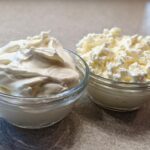Description
A guide to understanding and using sour cream and Greek yogurt as versatile ingredients in your cooking. Discover their differences, best uses, and healthy alternatives.
Ingredients
- Sour Cream
- Greek Yogurt
Instructions
- Understand the fat content and tang of sour cream.
- Understand the thickness and protein of Greek yogurt.
- Consider your recipe’s needs for creaminess and flavor.
- Use Greek yogurt as a lighter, protein-rich substitute for sour cream in dips and dressings.
- Use sour cream for richer, more traditional baked goods and sauces.
- Experiment with combinations for balanced flavor and texture.
Notes
- Greek yogurt is generally thicker and has more protein than sour cream.
- Sour cream offers a richer mouthfeel and a distinct tang.
- Both can be used in baking, but may affect texture differently.
- Greek yogurt can be strained further to achieve a thicker consistency similar to sour cream.
- Prep Time: 5 minutes
- Cook Time: 0 minutes
- Category: Ingredient Guide
- Method: Comparison and Substitution
- Cuisine: International
Nutrition
- Serving Size: 1 tablespoon
- Calories: 20-30 (Greek Yogurt), 25-35 (Sour Cream)
- Sugar: 1-2g
- Sodium: 10-15mg
- Fat: 0-5g (Greek Yogurt), 2-4g (Sour Cream)
- Saturated Fat: 0-3g
- Unsaturated Fat: 0-1g
- Trans Fat: 0g
- Carbohydrates: 1-3g
- Fiber: 0g
- Protein: 2-4g (Greek Yogurt), 1g (Sour Cream)
- Cholesterol: 5-15mg
Keywords: sour cream, Greek yogurt, ingredient swap, recipe substitute, healthy alternatives, meal prep, dips, dressings, low fat, protein-rich, baking, cooking
